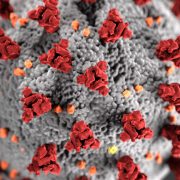The risk from SARS‐CoV‐2 to bat species in England and mitigation options for conservation field workers
The risk from SARS‐CoV‐2 to bat species in England and mitigation options for conservation field workers
Published 22 March 2021
Common, S.M. et al (2021) The risk from SARS‐CoV‐2 to bat species in England and mitigation options for conservation field workers. Transboundary and Emerging Diseases. https://doi.org/10.1111/tbed.14035
This paper reports on a qualitative disease risk analysis (DRA), undertaken to assess the risk of disease from SARS‐CoV‐2 to free‐living bats from fieldworkers carrying out bat conservation interventions and development activities in England. The probability of disease occurring and the magnitude of the possible consequences to bat populations were assessed and mitigation methods proposed.
The disease risk assessment was carried out by staff from The Institute of Zoology and Natural England, according to the method described by the OIE. Assessment was undertaken of the biological pathways that might permit bats to be exposed and infected with SARS‐CoV‐2, as well as the probability of exposure and infection occurring.
The probability of exposure of bats to SARS‐CoV‐2 through fieldwork activities was estimated to range from negligible to high, depending on the proximity between bats and people during the activity. The likelihood of infection after exposure was estimated to be high and the probability of dissemination of the virus through bat populations medium.
There is uncertainty in the pathogenicity of SARS‐CoV‐2 in bats, with the authors reporting that SARS‐CoV‐2 has been demonstrated experimentally to infect one species of bat, but another has been shown to be experimentally resistant. Therefore, although the likelihood of clinical disease occurring in infected bats was assessed as low there is some uncertainty in this risk estimation. The authors note that the disease risk analysis should be updated as information on the epidemiology of SARS‐CoV‐2 and related viruses in bats improves.
The authors conclude that the probability of infection can be effectively reduced if fieldworkers follow routine government guidance, and minimum precautions have been set out in advice provided by DEFRA to Natural England and in addition follow strict biosecurity measures when contacting bats or possible fomites which may expose bats to the virus, including the use of disposable gloves, cloth face coverings, effective hand cleansing and appropriate disinfecting of equipment.
Guidance
Natural England (2020). COVID‐19 and interacting with wildlife for the purposes surveying and mitigation works [online] Available from: https://www.gov.uk/guidance/coronavirus-covid-19-surveying-and-mitigation-works-affecting-wildlife [Accessed 22 March 2021]
Botto Nunez, G. et al (2020) IUCN SSC Bat Specialist Group (BSG) recommended Strategy for researchers to reduce the risk of transmission of SARS-CoV-2 from humans to bats [online] Available from: https://www.iucnbsg.org/uploads/6/5/0/9/6509077/map_recommendations_for_researchers_v._1.0_final.pdf [Accessed 22 March 2021]


Leave a Reply
Want to join the discussion?Feel free to contribute!